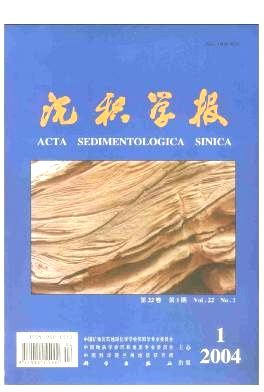|
[1]
|
[ |
|
[2]
|
张锦泉,叶红专.论碳酸盐与陆源碎屑的混合沉积.成都地质学院学报,1989,16(2):87~92[Zhang Jinquan and Ye Hongzhuan. Study on carbonate and siliciclastic mixed sediments. Journal college of Chengdu of Geology,1989,16(2): 87~92] |
|
[3]
|
杨朝青,沙庆安.云南曲靖中泥盆统曲靖组的沉积环境:一种陆源碎屑与海相碳酸盐的混合沉积.沉积学报,1990,8(2):59~66[Yang Chaoqing and Sha Qingan. Sedimentary environment of the middle Devonian Qujiang formation, a kind of mixing sedimentation of terrigenous clastics and carbonate.Acta Sedimentologica Sinica,1990,8(2):59~66] |
|
[4]
|
张雄华. 混积岩的分类和成因.地质科技情报,2000,19(4):31~34[Zhang Xonghua. Classification and origin of mixosedimentite. Ge0logical Science and Technology Ingormation,2000,19(4):31~34] |
|
[5]
|
沙庆安. 混合沉积和混积岩的讨论.古地理学报,2001,3(3):63~66[Sha Qingan. Discussion on mixing deposit and Hunji rock. Journal of Palaeogeography,2001,3(3):63~66] |
|
[6]
|
王国忠. 南海北部大陆架现代礁源碳酸盐与陆源碎屑的混合沉积作用.古地理学报,2001,3(2):47~54[Wang Guozhong. Mixed sedimentation of recent reefoid carbonates and terrigenous clastics in the North continental shelf of the South China sea. Journal of Palaeogeography,2001,3(2):47~54] |
|
[7]
|
Zuff G G. Hybrid arenites: Their composition and classification. Journal of Sedimentary Petrology, 1980,50(1):21~29 |
|
[8]
|
关士聪,演怀玉,丘东洲,等.中国晚元古代至三叠纪海域沉积环境模式探讨.石油与天然气地质,1980,1(1):2~17[Guan Shicong,Yan Huaiyu and Qiu Dongzhou. Investigations on the marine sedimentary environmental model of China in late Proterozoic to Triassic periods. Oil & Gas Geology,1980,1(1):2~17] |
|
[9]
|
刘宝珺,余光明,王成善,等.珠穆朗玛峰地区侏罗纪沉积环境.沉积学报,1983,1(2):1~16[Liu Baojun,Yu Guangming, Wang Chengshan, et al. Jurassic sedimentary environment in the Qomolangma region. Acta Sedimetologica Sinica,1983,1(2):1~16] |
|
[10]
|
Mount J F. Mixing of siliciclastics and carbonate sediments in shallow shelf environments. Geology,1984,12:432~435 |
|
[11]
|
Mount J F. Mixed siliclastic and carbonate sediments: A proposed first-order textural and compositional classification. Sedimentology, 1985,32:435~442 |
|
[12]
|
王国忠,吕炳全,全松青.现代碳酸盐岩与陆源碎屑的混合沉积作用-涠洲岛珊瑚岸礁实例.石油与天然气地质,1987,8(1):15~25[Wang Guozhong,Lu Bingquan and Quan Songqing. Mixed sedimentation of recent carbonates and terrigenous clastics. Oil & Gas Geology,1987,8(1):15~25] |
|
[13]
|
郭福生.江山石炭纪和二叠纪沉积相.华东地质学院学报,1990,13(4):57~65[Guo Fusheng. Sedimentary facies of the Carboniferous and Permian in Jiangshan. Journal of East China College of Geology,1990,13(4):57~65] |
|
[14]
|
郭福生.浙江江山晚古生代岩相古地理及其构造控制.岩相古地理,1993,13(6):44~52[Guo Fusheng. Late Palaeozoic sedimentary facies and Palaeogeography and their tectonic controls in Jiangshan, Zhejiang. Sedimentary Facies and Palaeogeography, 1993,13(6):44~52] |
|
[15]
|
张锦泉,陈洪德,叶红专.碳酸盐与陆源碎屑的混合沉积.见:冯增昭,王英华,刘焕杰.中国沉积学.北京:石油工业出版社,1994. 623~631[Zhang Jinquan,Chen Hongde and Ye Hongzhuan. Mixing depositional of carbonate and terrigenous clastics.In: Feng Zengzhao,Wang Yinghua and Liu Huajie. Sedimentary Petrology of China. Beijing: Petroleum Industry Publishing House,1994. 623~631] |
|
[16]
|
江茂生,沙庆安,刘敏.华北下中寒武统碳酸盐与陆源碎屑混合沉积--以山东张夏地区为例.沉积学报,1996,14(增刊):63~74[Jiang Maosheng,Sha Qingan and Liu Min. Mixed siliciclastic-carbonate sediment during the lower-middle Cambrian in the North China Platform. Acta Sedimentologica Sinica,1996,14(Suppl.):63~74] |
|
[17]
|
殷勇,董玉珊,高长林,等. 中天山马鞍桥石炭纪沉积特征及构造意义.沉积学报,2000,18(1):100~106[Yin Yong,Dong Yushan,Gao Changlin,et al. Depositional characteristics of Carboniferous and its tectonic significance in Maanqiao area, middle Tianshan. Acta Sedimentologica Sinica,2000,18(1):100~106] |
|
[18]
|
王冠民. 西藏措勤盆地下白垩统多巴组沉积环境分析.沉积学报,2000,18(3):349~354[Wang Guanmin. Sedimentary environment of the lower Cretaceous Duoba Formation of the Cuoqin Foreland basin in Tibet. Acta Sedimentologica Sinica,2000,18(3):349~354] |
|
[19]
|
沙庆安. 混积岩一例--滇东震旦系陡山沱组砂质砂屑白云岩的成因.古地理学报,2001,3(4):56~60[Sha Qingan. An example of Hunji rock-origin of sandy doloarenite of the Sinian Doushantuo Formation in Eastern Yunnan province. Journal of Palaeogeography,2001,3(4):56~60] |
|
[20]
|
蒋凌志,顾家裕. 塔里木盆地麦盖提斜坡石炭系碳酸盐岩和碎屑岩交替沉积的沉积环境分析.石油实验地质,2002,24(1):41~47[Jiang Lingzhi and Gu Jiayu. Application of depositional base-level concept in sequence stratigraphic division,correlation and litho-stratigraphic traps prediction. Petroleum Geology & Experiment,2000,24(1):41~47] |
|
[21]
|
徐德斌,白志达,王敦则,等.河北省兴隆地区大红峪组沉积古环境研究.地层学杂志,2002,26(1):73~79[Xu Debin,Bai Zhida,Wang Dunze,Mei Minxiang and Li Zhizhong. On sedimentary environment of the Dahongyu Formation in Xinglong region, Hebei. Journal of Stratigraphy,2002,26(1):73~79] |
|
[22]
|
刘宝珺,王剑,谢渊,等. 当代沉积学研究的新进展与发展趋势--来自第三十一届国际地质大会的信息.沉积与特提斯地质,2002,22(1):1~6[Liu Baojin,Wang Jian,Xie Yuan,Xu Qiang,Mu Chuanlong,Zhu Tongxing,Luo Jianning,Tan Fuwen and Li Zhixong. The development and trend in the research of modern sedimentology- from the 31st International Geology Convention. Sedimentary Geology and Tethyan Geology,2002,22(1):1~6] |
|
[23]
|
全国地层委员会.全国地层会议学术报告汇编(浙西地层现场会议).北京:科学出版社,1963[Stratum Committee of China. Reports Compilation of China Stratum Convention (Western Zhejiang Province Stratum Convention). Beijing: Science Press,1963] |
|
[24]
|
韩乃仁.浙江江山古生代地层研究述评.桂林工学院学报,1996,16(3):203~216 [Han Nairen. Comment on the research on palaeontology and strata from Jiangshan, Zhejiang. Journal of Gulin Institute of Technology,1996,16(3):203~216] |
|
[25]
|
卢衍豪,穆恩之.浙西古生代地层新见.地质知识,1955,(2):1~6[Lu Yanhao and Mu Enzhi. Re-cognition of Paleozoic strata of Western Zhejiang. Geological Knowledge,1955,(2):1~6 ] |
|
[26]
|
浙江省区域地层表编写组.华东地区区域地层表(浙江省分册).北京:地质出版社,1979.93~106[Compilation Group of Region Stratigraphical Table of Zhejiang Province. Regional Stratigraphical Table of East China Area (Fascicule of Zhejiang Province). Beijing: Geological Publishing House,1979. 93~106] |
|
[27]
|
陈联儿.江山的石炭系和二叠系.华东地质学院学报,1990,13(4): 35~48 [Chen Lianer. The Carboniferous and Perian of Jiangshan. Journal of East China College of Geology, 1990, 13 (4): 35~48] |
|
[28]
|
郭福生.浙江江山岩石地层单位的厘定及应用研究.华东地质学院学报,1994,17(3):254~263 [Guo Fusheng. On collating and applying of the lithostratigraphic units in Jiangshan area, Zhejiang. Journal of East China College of Geology,1994,17(3):254~263] |
|
[29]
|
浙江省地质矿产局.浙江省区域地质志.北京:地质出版社,1989. 96~98,102~104 [Bureau of Geology and Mineral Resources of Zhejiang Province. Regional Geology of Zhejiang Province. Beijing: Geological Publishing House,1989. 96~104] |
|
[30]
|
江西省地质矿产厅.江西省岩石地层.武汉:中国地质大学出版社,1997. 189~192 [Department of Geology and Mineral Resources of Jiangxi Province. Stratigraphy (Lithostratic) of Jiangxi Province. Wuhan: China University of Geosciences Press,1997. 189~192] |
|
[31]
|
安徽省区域地层表编写组.华东地区区域地层表(安徽省分册).地质出版社,1978. 216~249 [Compilation Group of Region Stratigraphical Table of Anhui Province. Region Stratigraphical Table of East China Area (Fascicule of Anhui Province). Geological Publishing House, 1978.216~249] |
|
[32]
|
田京辉,倪培,范建国. 永平铜矿成矿流体特征研究.地质找矿论丛,2001,16(1)24~27[Tian Jinghui,Ni Pei and Fan Jianguo. Ore-forming fluid characteristics research of Yongping copper deposit. Contributions to Geology and Mineral Resources Research,2001,16(1):24~27] |
|
[33]
|
汪华敏.中国南方中晚石炭世沉积相及沉积模式.沉积学报,1986,4(3):57~65[Wang Huamin. Middle-late Carboniferous sedimentary facies and model in the South China. Acta Sedimentologica Sinica,1986,4(3): 57~65] |






 DownLoad:
DownLoad: